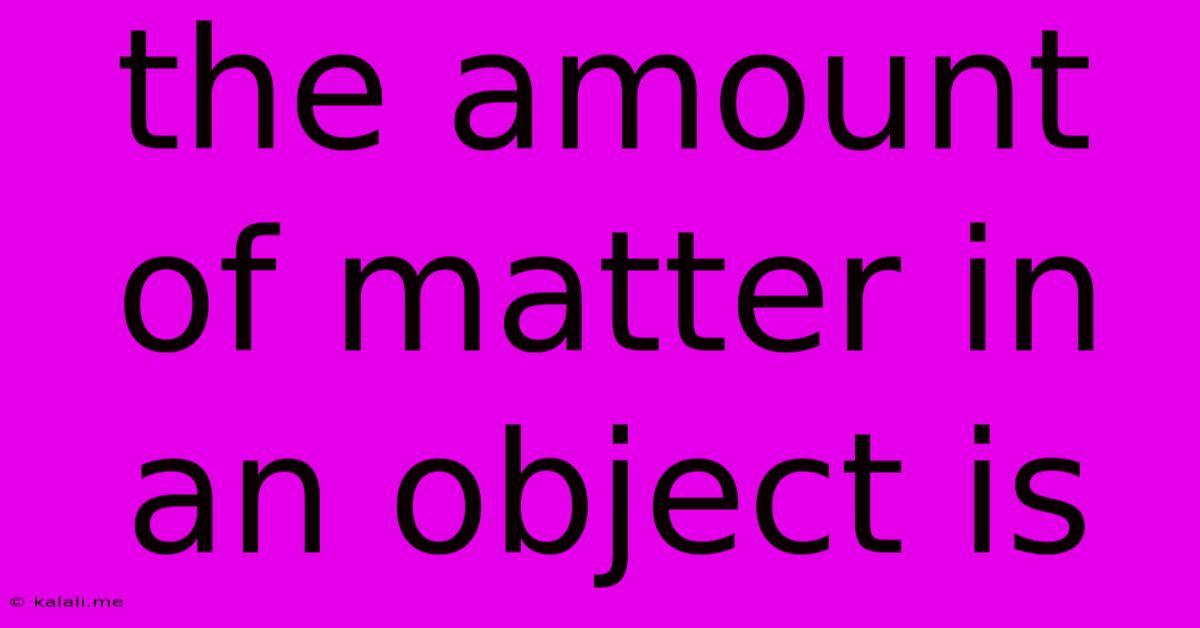The Amount Of Matter In An Object Is
Kalali
May 10, 2025 · 3 min read

Table of Contents
The Amount of Matter in an Object: Understanding Mass and Its Properties
The amount of matter in an object is its mass. This seemingly simple concept is fundamental to our understanding of physics and the universe. This article will delve into what mass is, how it's measured, and its relationship to other crucial concepts like weight and density.
Mass is a scalar quantity, meaning it only has magnitude (size) and no direction. It represents the resistance of an object to acceleration, often described as inertia. The more massive an object, the harder it is to change its velocity—whether it's starting it from rest, speeding it up, slowing it down, or changing its direction. This is why a heavier car is harder to push than a lighter one.
What is the Difference Between Mass and Weight?
While often confused, mass and weight are distinct concepts. Mass is an intrinsic property of an object – it's the amount of matter it contains and remains constant regardless of location. Weight, on the other hand, is the force of gravity acting on an object's mass. Weight is a vector quantity, possessing both magnitude and direction (always towards the center of the gravitational field).
Think of it this way: your mass stays the same whether you're on Earth or the Moon. However, your weight would be significantly less on the Moon because the Moon's gravitational pull is weaker than Earth's. This difference highlights the crucial distinction between mass and weight.
Measuring Mass
Mass is typically measured using a balance scale. This instrument compares the mass of an unknown object to a known mass (often standard weights). The balance works based on the principle of comparing gravitational forces, but ultimately measures mass due to its comparison to a known mass standard. Other methods include using an inertial balance, which measures an object's resistance to acceleration, providing a more direct measurement of mass independent of gravity.
Mass and Density: A Close Relationship
Another important concept related to the amount of matter is density. Density is the mass of a substance per unit volume. This means that a denser object packs more mass into a given space. For example, lead has a higher density than wood, meaning a cubic centimeter of lead contains significantly more mass than a cubic centimeter of wood. The formula for density is:
Density = Mass / Volume
Understanding density is crucial in many fields, from engineering (designing structures that can withstand specific loads) to geology (determining the composition of rocks and minerals).
Mass in Different Contexts
The concept of mass extends beyond everyday objects. In physics, particularly in Einstein's theory of relativity, mass and energy are interchangeable according to the famous equation E=mc². This equation shows that a small amount of mass can be converted into a tremendous amount of energy, as seen in nuclear reactions.
In chemistry, understanding the mass of atoms and molecules is fundamental for stoichiometry (the calculation of reactants and products in chemical reactions). The molar mass, representing the mass of one mole of a substance, is a crucial tool in quantitative chemistry.
In conclusion, the amount of matter in an object is its mass, a fundamental property distinct from weight. Understanding mass, its measurement, and its relationship to density is crucial for comprehending various scientific concepts across multiple disciplines. From everyday observations to complex scientific theories, the concept of mass remains a cornerstone of our understanding of the physical world.
Latest Posts
Latest Posts
-
Jaguar Adaptations In The Tropical Rainforest
May 10, 2025
-
How To Find Average Velocity From Velocity Time Graph
May 10, 2025
-
What Is Non Living Things In The Ecosystem
May 10, 2025
-
How Many Fl Oz In 6 Cups
May 10, 2025
-
What Is 1 Percent Of 5000
May 10, 2025
Related Post
Thank you for visiting our website which covers about The Amount Of Matter In An Object Is . We hope the information provided has been useful to you. Feel free to contact us if you have any questions or need further assistance. See you next time and don't miss to bookmark.